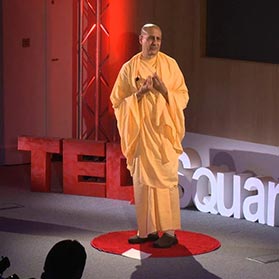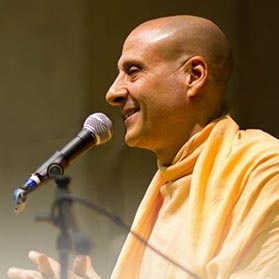It’s early Saturday evening at the Rubin Museum of Art, located around the corner from Barneys New York in Chelsea. Every seat in the sleek basement theater is filled by an earnest crowd of limber New Yorkers, many tattooed and top-knotted, wrists heavy with looping strands of wooden beads. They are gathered for a talk by Radhanath Swami, who has been for 20 years a leader of the International Society for Krishna Consciousness, better known as the Hare Krishna. It’s early Saturday evening at the Rubin Museum of Art, located around the corner from Barneys New York in Chelsea. Every seat in the sleek basement theater is filled by an earnest crowd of limber New Yorkers, many tattooed and top-knotted, wrists heavy with looping strands of wooden beads. They are gathered for a talk by Radhanath Swami, who has been for 20 years a leader of the International Society for Krishna Consciousness, better known as the Hare Krishna.
It’s early Saturday evening at the Rubin Museum of Art, located around the corner from Barneys New York in Chelsea. Every seat in the sleek basement theater is filled by an earnest crowd of limber New Yorkers, many tattooed and top-knotted, wrists heavy with looping strands of wooden beads. They are gathered for a talk by Radhanath Swami, who has been for 20 years a leader of the International Society for Krishna Consciousness, better known as the Hare Krishna.It’s early Saturday evening at the Rubin Museum of Art, located around the corner from Barneys New York in Chelsea. Every seat in the sleek basement theater is filled by an earnest crowd of limber New Yorkers, many tattooed and top-knotted, wrists heavy with looping strands of wooden beads. They are gathered for a talk by Radhanath Swami, who has been for 20 years a leader of the International Society for Krishna Consciousness, better known as the Hare Krishna.










